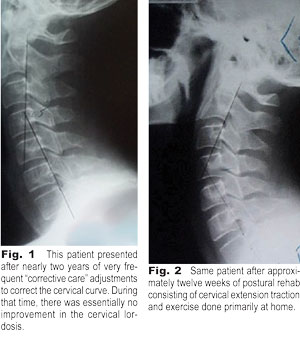Everyday, countless patients consult chiropractors seeking a solution for their problems. While some doctors confine themselves to purely symptomatic care, others will recommend treatment well beyond simple relief of pain. Such programs are typically geared toward “correcting the cause” of trouble and often require a considerable commitment of time and money by the patient. Unfortunately, many such programs which rely heavily on a lengthy series of adjustments to “correct” the spine will be doomed to failure.
The ugly truth for chiropractic is that our traditional methods of adjusting the spine do very little to restore normal spinal alignment. Traditional chiropractic care has helped millions to live healthier, happier lives and you can definitely count me as a true “believer.” Unfortunately, regardless of what we may believe, numerous studies in reputable, peer reviewed journals have failed to show significant spinal correction from adjustments alone. Correction of spinal misalignment/subluxation has been our profession’s raison d’être since day one. The fact that our main method of treatment, the chiropractic adjustment, does very little to actually correct the underlying structure of the spine is problematic for “corrective care” practitioners, unless they are willing to embrace more effective methods of rehabilitating spinal posture.

Let’s take a very common postural problem, loss of the normal cervical lordosis, as an example. Many chiropractors will X-Ray their patient, detect a chronic loss of cervical lordosis, and prescribe a lengthy regimen of adjustments to address the problem. All of which is fine, as long as both doctor and patient can reasonably expect a positive outcome. Most of the techniques studied to date appear to yield only about four or five degrees of correction on average. The cold, hard truth is that we have very little evidence to demonstrate that ANY method of adjusting is particularly effective at restoring the cervical lordosis. In spite of this, many well-meaning doctors continue to recommend long, protracted programs of adjustments which have little chance of success, simply because that is the way they were trained and they aren’t aware of other treatment options.
So, if adjustments alone aren’t getting the job done, are there other methods we might use to obtain better corrective care outcomes? A 1994 study in the Journal of Manipulative and Physiological Therapeutics shed new light on what might actually work in terms of correcting the cervical curves. The study, the first of its kind, looked at three treatment groups. Group one consisted of thirty-five patients treated using diversified manipulation and drop table adjusting in combination with cervical extension traction methods. Group two received identical adjustment without extension traction and, finally, a third control group received no treatment. At the end of the study (ten to fourteen weeks later), twenty-nine of thirty-five patients in the treatment group one (the traction and adjustment group) had a lordotic curve compared to eleven of thirty-five prior to treatment. The average improvement in curve values was 13.2 degrees. That’s roughly 300 percent better than the four or five degrees of correction typically obtained with adjustments only! Since the original study in 1994, two additional studies produced similar results supporting the use of extension traction methods to restore the normal cervical lordosis.
Caution: Extension traction involves applying traction force with the head and neck in full backward extension relative to the thorax, not simply stretching the spine along the long axis as with typical medical type traction. Pronounced extension movements of the head and neck may be contraindicated for certain patients. I strongly caution all doctors to carefully screen their patients before using any form of cervical extension traction.

In my next article, I’ll cover some of the reasons underlying why it is so difficult to actually achieve meaningful structural corrections with adjustments alone. Between now and then, please take a moment to consider this: For decades, chiropractors have struggled to correct the spine by simply adjusting the column back toward proper alignment. Now, a hundred years into our profession, we are finally starting to understand what it takes to actually deliver on the promise of corrective chiropractic care.
Dr. Mark Payne is the president of Matlin Mfg., a manufacturer and distributor of postural rehab products since 1988. To download a full and unabridged version of this article, link to www.MatlinMfg.com. Interested doctors may contact our office for my FREE REPORT, Suggested Screening Procedures for Patient Safety.
If you are interested in learning more on the subject, call our office. I’ll be glad to share how you can improve your corrective care outcomes by 200-300 percent over adjusting alone without changing your technique or spending a fortune. Contact us at 1-334-448-1210 for your Free Report on patient safety.
